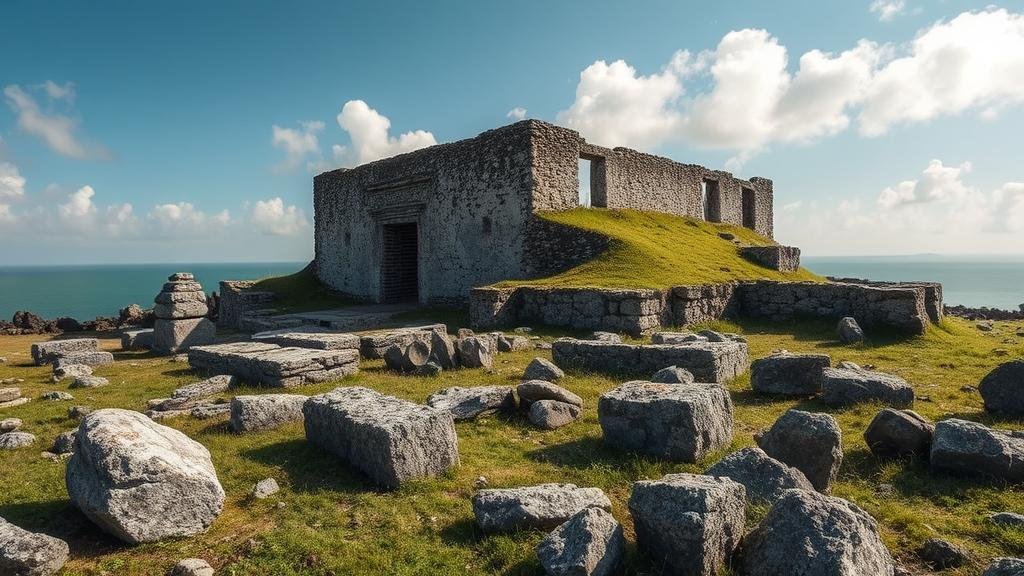Searching for ruins on islands rumored to vanish and reappear cyclically.
Searching for Ruins on Islands Rumored to Vanish and Reappear Cyclically
The concept of islands that vanish and reappear has captivated explorers, historians, and adventurers for centuries. The tales surrounding these enigmatic lands often blur the line between fact and fiction, offering a tantalizing glimpse into the mysteries of our planets geography. This article delves into the phenomenon of cyclical islands, exploring their historical context, notable examples, and the scientific explanations behind these myths.
The Legend of Vanishing Islands
Legends of disappearing islands are prevalent across various cultures. One of the most famous tales is that of Atlantis, a purported advanced civilization that supposedly lies submerged beneath the ocean. First mentioned by the ancient Greek philosopher Plato around 360 BC, Atlantis has inspired countless theories regarding its location–ranging from the Mediterranean to the Caribbean. While Atlantis itself may be more myth than reality, there are several islands that have piqued the interest of both scientists and adventurers.
Case Studies of Notable Vanishing Islands
Several islands have gained notoriety for their alleged ability to disappear and reappear, reinforcing the allure of these legends:
- Bermeja Island: Located in the Gulf of Mexico, Bermeja was said to be a crucial navigational point and a treasure island rumored to disappear in the 19th century. Despite extensive searches, its existence was never definitively proven. The Mexican government still includes it in its official maps, fueling ongoing speculation.
- Hy-Brasil: A phantom island said to be located off the west coast of Ireland, Hy-Brasil was first documented in 1325. Tales of its reappearance led many to search for it, but it has never been found. Some theorists suggest it may have been a misinterpretation of nearby landmasses.
- Sandbank of the Cocos (Keeling) Islands: This remote group of islands in the Indian Ocean has its own vanishing tale. Some reports from sailors in the early 1900s noted that certain sandbanks would appear at low tide but vanish during high tide. This phenomenon is attributed to shifting sands and tidal dynamics.
Scientific Perspectives on Vanishing Islands
The scientific community often explains the myths of vanishing islands through natural phenomena such as erosion and geological changes. For example, many islands experience significant shifts in their topography due to:
- Tectonic activity: Earth’s tectonic movements can lead to the gradual sinking or rising of land masses.
- Sealevel rise: Climate change and the consequent melting of polar ice caps have resulted in rising sea levels, which threaten low-lying islands.
- Tidal influences: Strong currents and tidal forces can cause shifting landscapes, creating the illusion of islands appearing and disappearing.
Modern Expeditions and Technologies
In recent years, technological advancements have enabled more effective searches for these mystical islands. The use of satellite imaging, sonar mapping, and geographic information systems (GIS) has provided a new lens through which researchers can investigate historical anomalies. For example, a 2018 expedition to the Bering Sea utilized sonar mapping to examine underwater topographies associated with legendary vanishing islands in the area.
Real-World Applications and Cultural Significance
The legends of disappearing islands often serve as cautionary tales about environmental issues and the importance of understanding our natural world. In many cultures, these tales have encouraged explorations that yield valuable data on marine biodiversity and ecological shifts.
Plus, the ongoing interest in these islands underscores humanity’s desire to explore the unknown and our intrinsic connection to myth. Universities and research institutions are increasingly examining these myths to understand historical navigation and maritime culture.
Actionable Takeaways
If you are intrigued by the concept of vanishing islands, consider the following actions:
- Research reputable books or documentaries about mysterious islands and their histories.
- Participate in community discussions or online forums focused on maritime myths and realities.
- Support conservation efforts aimed at protecting vulnerable coastal regions threatened by climate change.
In summary, the search for ruins on islands rumored to vanish and reappear is not merely an exercise in fantasy; it encapsulates a blend of history, science, and environmental consciousness. As technology continues to evolve, the secrets of these remarkable locations may one day come into clearer focus, bridging the gap between legend and reality.



